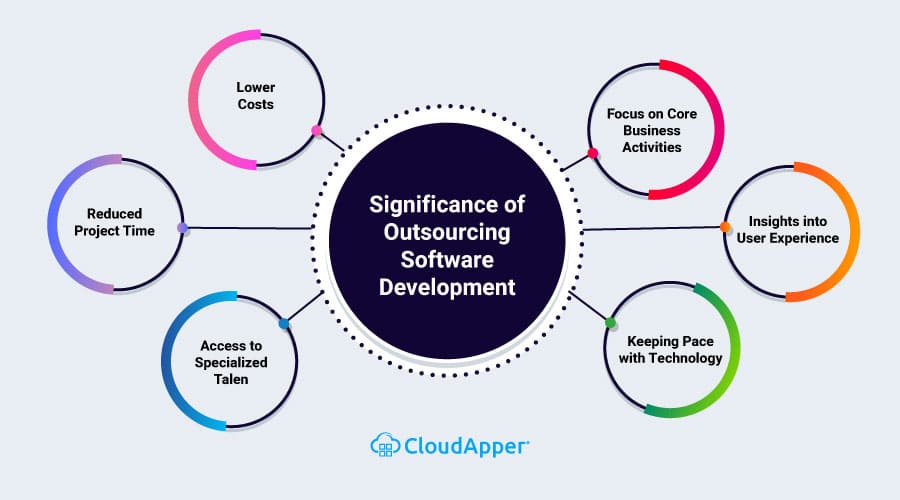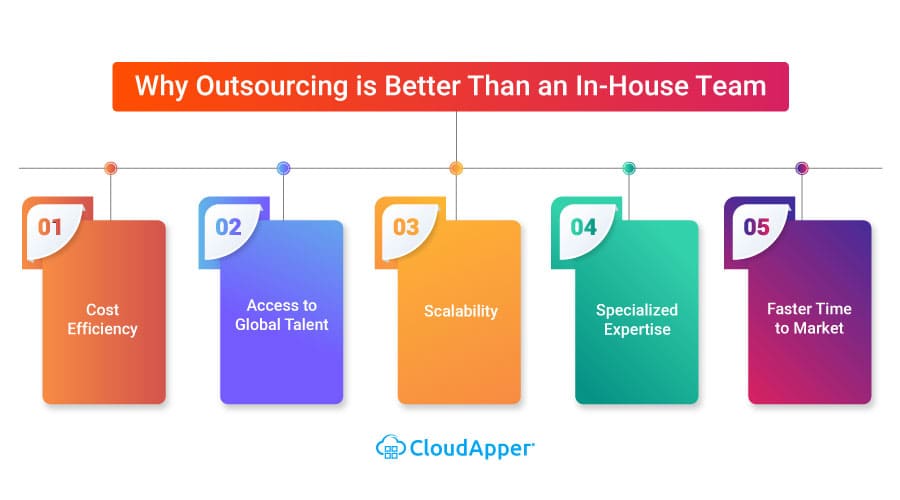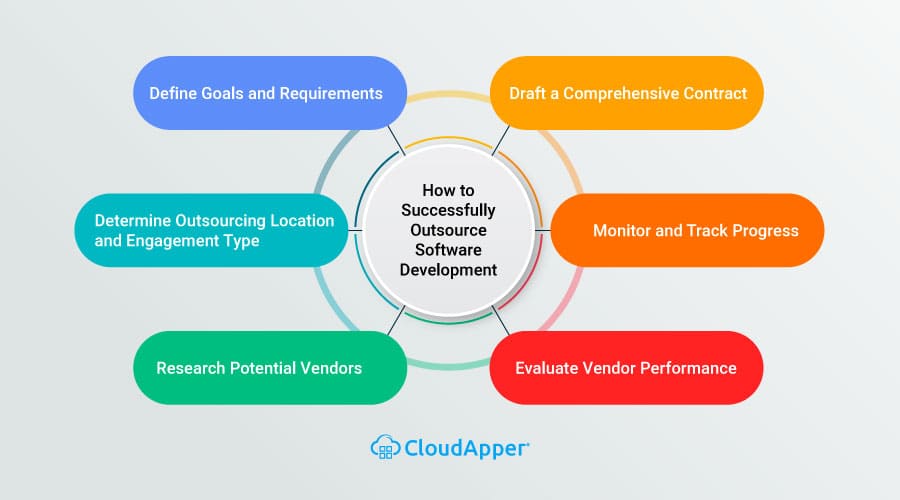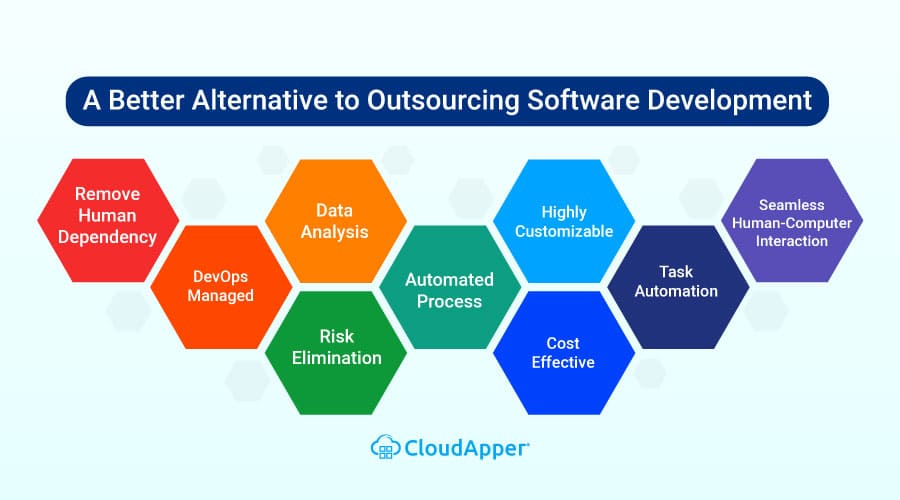CloudApper AI offers a comprehensive solution for software development, eliminating the need for outsourcing. With automation, customizable options, and seamless human-computer interaction, CloudApper AI optimizes productivity and efficiency, reducing costs and time associated with traditional development methods. Take your software development to the next level with CloudApper.

Software development outsourcing has become a popular business model for companies looking to accelerate their projects, reduce costs, and access specialized talent. If you’re considering outsourcing software development, here’s a comprehensive guide to help you navigate the process and ensure success.
What is Software Development Outsourcing?
Software development outsourcing refers to the practice of delegating software development tasks to third-party vendors, often located in nearshore or offshore regions. Instead of relying solely on an in-house team, companies leverage external expertise to complete projects more efficiently and cost-effectively.
Software Development Outsourcing Models
When considering software development outsourcing, it’s important to understand the various models that exist to establish a successful client and provider relationship. Here are three key relationship-based models to consider:
- Staff Augmentation: In the staff augmentation model, the client retains full ownership of the project throughout its lifecycle. The client hires tech talents from an outsourcing company to complement their in-house team and strengthen the development projects. The client takes on the majority of the responsibility for the project’s success.
- Managed Team: In the managed team model, responsibility and ownership are shared between the client and the outsourcing provider. The client and provider collaborate to determine which responsibilities belong to each party. A managed team, overseen by an outsourced Project Manager, operates independently of the client’s in-house team, managing daily operations and workflows.
- Project-Based: The project-based model involves the outsourcing provider taking on the majority of the responsibility and ownership of the project from start to finish. The provider completes the development projects according to the client’s specifications, ensuring timely delivery and meeting the project requirements.
It’s crucial to understand that different problems require different solutions and outsourcing models. Before seeking a solution, it’s important to identify the specific problem you need to address. If you’re new to outsourcing, staff augmentation can be a good starting point as it allows you to gain a feel for the outsourcing world. As your needs grow and your relationship with your outsourcing partner strengthens, you can explore other models of outsourcing that align with your evolving requirements.
| Model | Staff Augmentation | Managed Team | Project-Based |
| Ownership | The client has all rights to the finished product. | Client and outsourced company both own partial ownership. | The outsourcing company is responsible for it |
| Responsibility | The bulk of project responsibility rests with the client. | Client and service provider both have some of the blame | The onus of care is mostly on the provider. |
| Team Composition | The in-house staff of a customer benefits from the addition of outside expertise. | Managed team operates independently of the client’s in-house team | Provider’s team responsible for the project |
| Project Control | Client has direct control over the project and resources | Working together to divide labor and allocate resources | Provider has control over project and resources |
| Project Duration | Long-term engagement based on project requirements | Long-term engagement based on project requirements | Timing that coincides with the end of the project |
| Risk Distribution | The client takes full responsibility for the project’s outcome. | Shared risk between client and provider | Provider bears the risk associated with project success |
| Flexibility | Flexible resource scaling based on project needs | Scalability of resources according to project requirements | Fixed team size for the duration of the project |
| Focus | Client’s primary focus is on managing the project | Shared focus between client and provider | Project delivery is the provider’s first priority. |
| Suitable For | Short-term initiatives that work in tandem with the in-house team | Collaboration with an outsourced team, medium-term projects | Complete project outsourcing; outsourcing of extended projects |
In summary, choosing the right software outsourcing model depends on the unique needs and goals of your business. By understanding the different relationship-based models available, you can make informed decisions and establish a successful partnership with an outsourcing provider that best suits your specific requirements.
Significance of Outsourcing Software Development
Companies choose to outsource software development for various reasons, including:
Lower Costs: Outsourcing allows access to resources and personnel at a lower cost, leveraging economies of scale or labor cost advantages in different regions.
Reduced Project Time: By partnering with software development teams already equipped with the required skills, companies can expedite project timelines, avoiding the need for extensive training and onboarding.
Access to Specialized Talent: Outsourcing offers access to highly qualified professionals specializing in various technologies, helping bridge skills gaps and bringing new perspectives to the organization.
Focus on Core Business Activities: Outsourcing non essential tasks, such as software development, enables businesses to allocate resources to core competencies, maximizing efficiency and fostering innovation.
Insights into User Experience: Outsourced developers often possess market knowledge and user experience expertise, which companies can tap into to create cutting-edge products and improve user engagement.
Keeping Pace with Technology: External providers keep businesses up to date with the latest technology trends and best practices for digital product development.
Why Outsourcing is Better Than an In-House Team
Outsourcing software development offers distinct advantages over maintaining an in-house team, including:
Cost Efficiency: Outsourcing reduces overhead costs associated with hiring, training, infrastructure, and maintenance.
Access to Global Talent: Outsourcing expands the talent pool beyond local boundaries, enabling businesses to find the best-fit professionals worldwide.
Scalability: Outsourcing provides flexibility in scaling resources according to project requirements, ensuring optimal resource allocation.
Specialized Expertise: Outsourced teams often possess specialized knowledge and experience in specific technologies or industries.
Faster Time to Market: Leveraging external expertise allows for faster project initiation and completion, speeding up time to market for products or services.
How to Successfully Outsource Software Development
To ensure a successful outsourcing experience, consider the following best practices:
Define Goals and Requirements: Clearly define your software development goals, including functionality, long-term objectives, technical requirements, and integration with existing IT infrastructure.
Determine Outsourcing Location and Engagement Type: Decide whether nearshore or offshore outsourcing suits your needs, considering factors such as cultural compatibility, language barriers, and cost-effectiveness.
Research Potential Vendors: Conduct thorough research on software development companies, assessing their track record, customer feedback, and relevant experience in similar projects.
Draft a Comprehensive Contract: Create a detailed outsourcing contract that covers project milestones, deliverables, timelines, costs, payment terms, and ownership rights.
Monitor and Track Progress: Regularly communicate and track progress with the development team, ensuring alignment with requirements and addressing any issues promptly.
Evaluate Vendor Performance: Assess the vendor’s performance upon project completion, reviewing deliverables against expectations, timeliness, and overall satisfaction.
How to Choose The Best Software Development Company?
If you want to see your project through to fruition, outsourcing software development to the correct company is essential. The following advice should help you choose on the best course of action:
Evaluate their knowledge and expertise; choose a firm with a proven record of completing successful software development projects. Investigate their prior work, study case studies, and consult with satisfied customers for recommendations.
Think about how well they know your field. Verify that the outsourcing business you hire has prior experience with projects like yours and expertise in the technology stack you need. Inquire about their previous work in your field.
Think about the importance of communication in outsourcing. Make sure the firm you go with is easy to get in touch with and listens to what you have to say. Pick a business whose representatives speak your language and operate in the same time zone as you.
Determine if the outsourcing firm has a capable staff of developers who can complete your project. Inquire about their hiring practices and how they intend to keep their best employees around.
You should think about their prices and the conditions of their contracts before agreeing to anything. Find a business that is open and honest about their price, and can adjust to your needs in terms of both money and time.
Using these guidelines, you may find an outsourced software development firm that is ideal for your organization and your project. Best of luck!
Risks Associated With Outsourcing Software Development
There are hazards associated with outsourcing software development that you should be aware of. Outsourcing software development comes with a number of potential dangers, including:
Legal Protection Aspect: Having the legal and contractual components of the agreement correctly addressed is crucial for legal protection when outsourcing software development. Things like intellectual property rights, secrecy clauses, and conflict resolution processes fall under this category.
IP Risk: When outsourcing software development, be aware that dealing with a business headquartered in a nation with laxer intellectual property regulations might put your proprietary information at danger. Strong contractual safeguards should be in place to safeguard intellectual property.
Poor Quality of Service: If you don’t do your research, outsourcing software development might leave you with subpar results. It’s crucial to carefully select a software development partner with a proven history of completing high-quality projects.
Communication Problems: This is especially true if you are working with a firm in a different time zone or whose native language is not English. When hiring a firm, look for one with excellent communication skills and with whom you can create open lines of contact.
Lack of Control: Outsourcing software development may make it challenging to keep tabs on the development process and make sure the program is being built to your standards. A firm that is prepared to work closely with you to guarantee your needs are being met may help you build clear project management practices. Knowledge
Knowledge Loss: Knowledge loss is a potential outcome of bringing an offshore team in-house. This can occur when employees quit their positions or move on to other opportunities within the company. To achieve a seamless transition, you should establish a plan for knowledge transfer and select a business prepared to work closely with you.
Outsourcing software development may be an excellent strategy for gaining access to qualified developers and cutting expenses, but only if the associated dangers are understood and countered.
Introducing CloudApper: A Better Alternative to Outsourcing Software Development
While outsourcing software development has its benefits, CloudApper presents an alternative solution that eliminates the hassles associated with external vendors. Here’s why CloudApper stands out:
Remove Human Dependency: CloudApper removes the need to maintain a team of developers, eliminates concerns about poor coding skills, and prevents knowledge gaps when developers leave the company.
DevOps Managed: CloudApper takes care of maintenance, software updates, technical support, system upgrades, hosting management, and cybersecurity monitoring once the software is deployed.
Data Analysis: CloudApper’s AI systems analyze large datasets, extracting valuable information to help businesses improve products and services, making them more useful to customers.
Risk Elimination: Gain better control of your project with CloudApper, benefiting from custom branding, secured private cloud hosting, legal protection, and 24/7 technical support from a reputable US software development company.
Automated Process: CloudApper’s AI technology automates the software development process, ensuring rapid speed and human-error-free results.
Highly Customizable: CloudApper’s platform can tailor-make software according to specific organizational needs, providing a solution that aligns perfectly with your requirements.
Cost-Effective: CloudApper’s automation increases productivity and efficiency, making it a cost-effective solution for software development.
Task Automation: CloudApper AI automates repetitive and tedious tasks, allowing developers to focus on more complex and high-value tasks.
Seamless Human-Computer Interaction: CloudApper AI aims to create a natural, intuitive, and human-like interaction, enhancing user experience and making software development accessible and intuitive for businesses.
Final Words
In conclusion, a strategic strategy, distinct goals, and efficient vendor management are necessary for successful software development outsourcing. While there are many advantages to outsourcing, there is now another option that does away with the problems brought on by using outside vendors: CloudApper.
The complete platform offered by CloudApper eliminates the need for developers, automates the software development process, and delivers a highly configurable solution catered to the unique requirements of your firm. CloudApper enables enterprises to expedite their software development projects while optimizing productivity and efficiency with capabilities like task automation, data analysis, and seamless human-computer interface.
By using CloudApper, you may get rid of outsourcing’s risks, improve project control, and take advantage of the experience of a recognized US software development business. A fast and trouble-free software development process is guaranteed by CloudApper thanks to their managed DevOps, ongoing technical support, and 23 years of experience.
Don’t allow outsourcing’s difficulties to hinder you. Investigate the options with CloudApper to take your software development journey to the next level. To find out more and arrange a demo, go to our website right away. Take use of automated software development to its fullest and maximize the potential of your company.
To find out more and book a CloudApper demo, go to our website at www.cloudapper.com. Today, automate processes, streamline your software development process, and unlock the full potential of your company!

Brochure
CloudApper hrPad
Empower Frontline Employees with an AI-Powered Tablet/iPad Solution
Download Brochure
CloudApper AI Solutions for HR



- Works with
- and more.

















